Before I begin, just a little note to say that I really am talking about the Loir and not its cousin, the Loire River. We’ve been to Lavardin before – on a cold winter’s day in December last year during the Christmas markets – and promised we’d come back and cycle around the area in the summer.
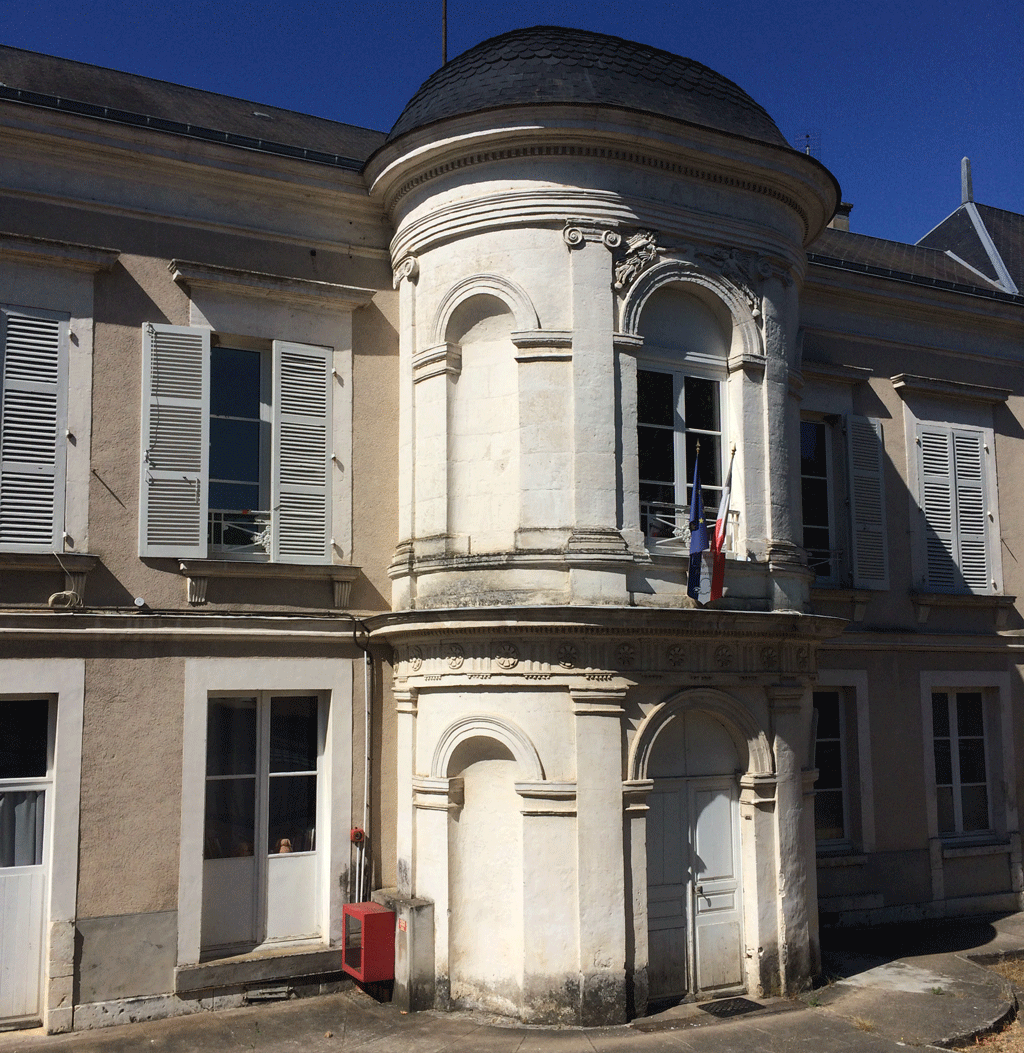
We’ve found an itinerary on the web that we’ve printed out and are starting at Villiers which is the closest point to Blois (50 mins away by car). We park in front of a school called Louis Gatien which must surely have been something else in its heyday. Nothing else could explain the entrance!
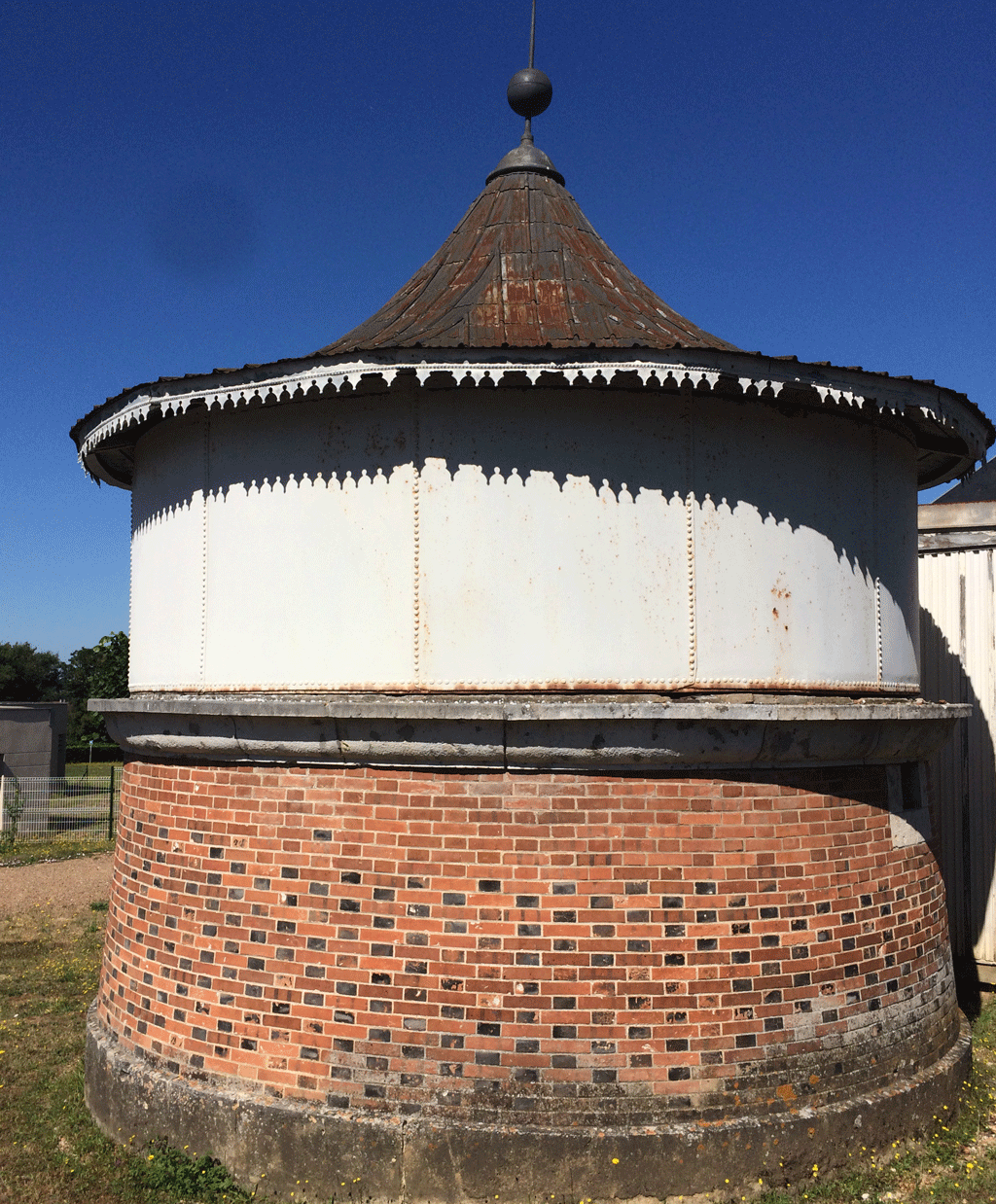
It has a large round building at one end that I later discover is a water tower with an artesian bore built by a Mr Fortier in 1868 for his personal use. It also supplied water to a wash-house; any surplus water was taken via a ditch to the Loir. Maybe the school was his house.
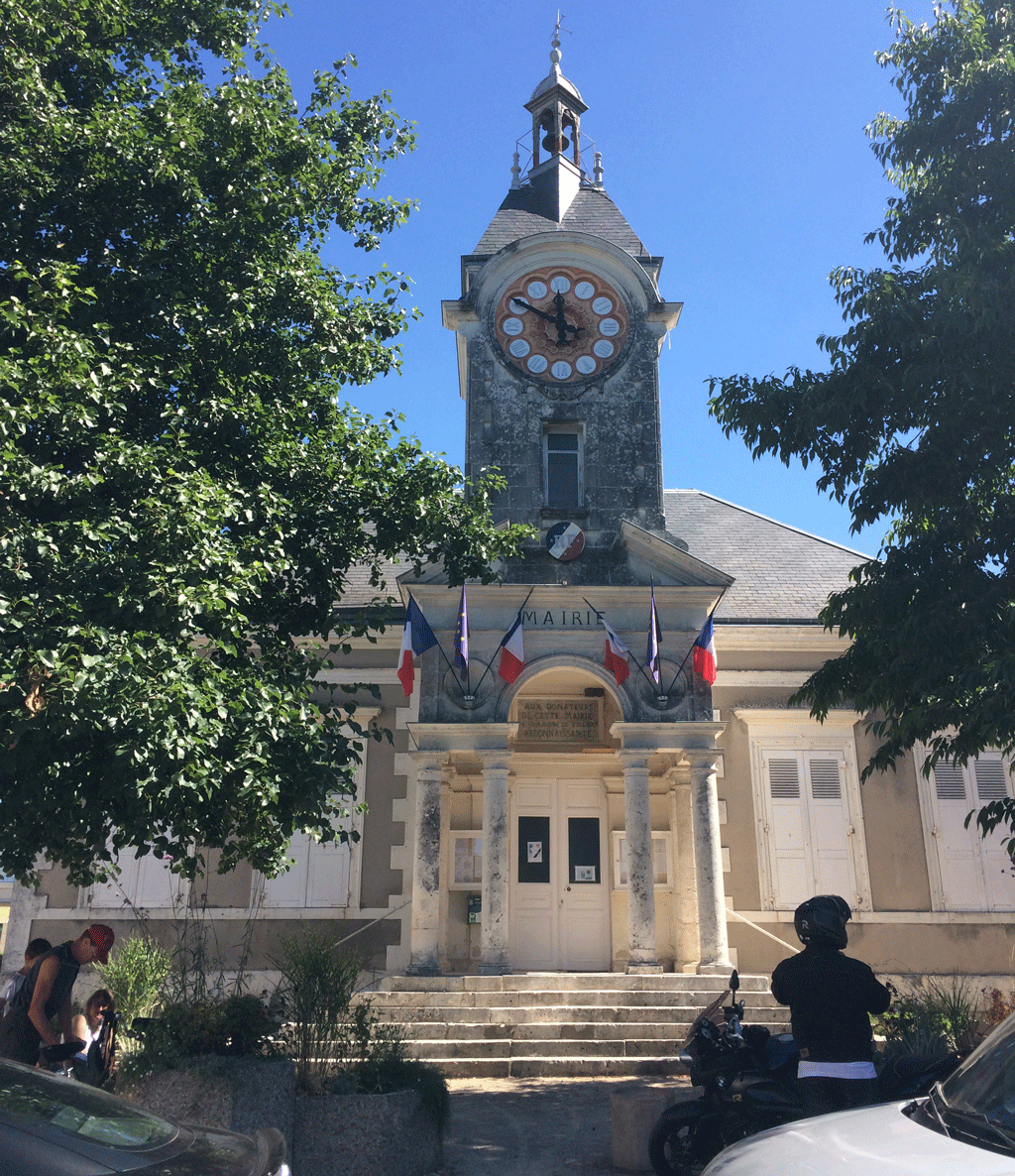
The centre of little town of Villiers, which has a population of just over 1,000, seems to be thriving. Around the central square is a church, a town hall with a 2-metre diameter monumental clock, a baker, a butcher, a Proxi supermarket, a bar, a restaurant and a hair-dressing salon. It’s Sunday morning and bustling with people.
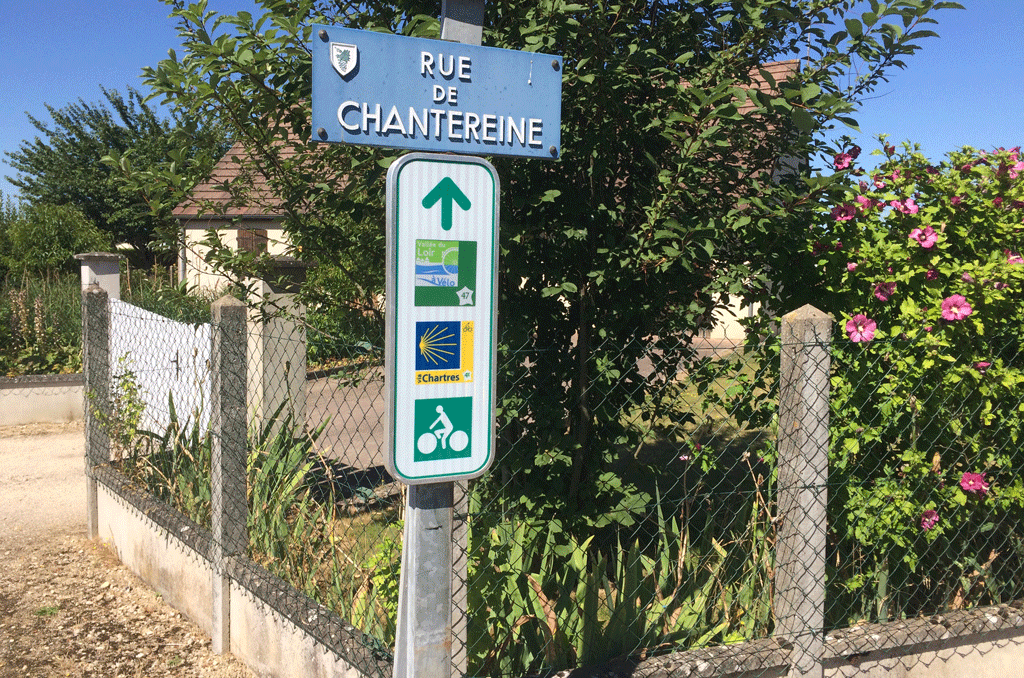
We see the little green and white bike route sign indicating Loire à Vélo and start following it. We are also on the Camino path. We go past an amazing number of troglodyte dwellings, some of which are quite sophisticated. One even has crenellations and bull’s eyes!

The first village is Thoré la Rochette built over the river. It has a hotel/bar/restaurant that is actually open (but it’s too soon for a capuccino stop).
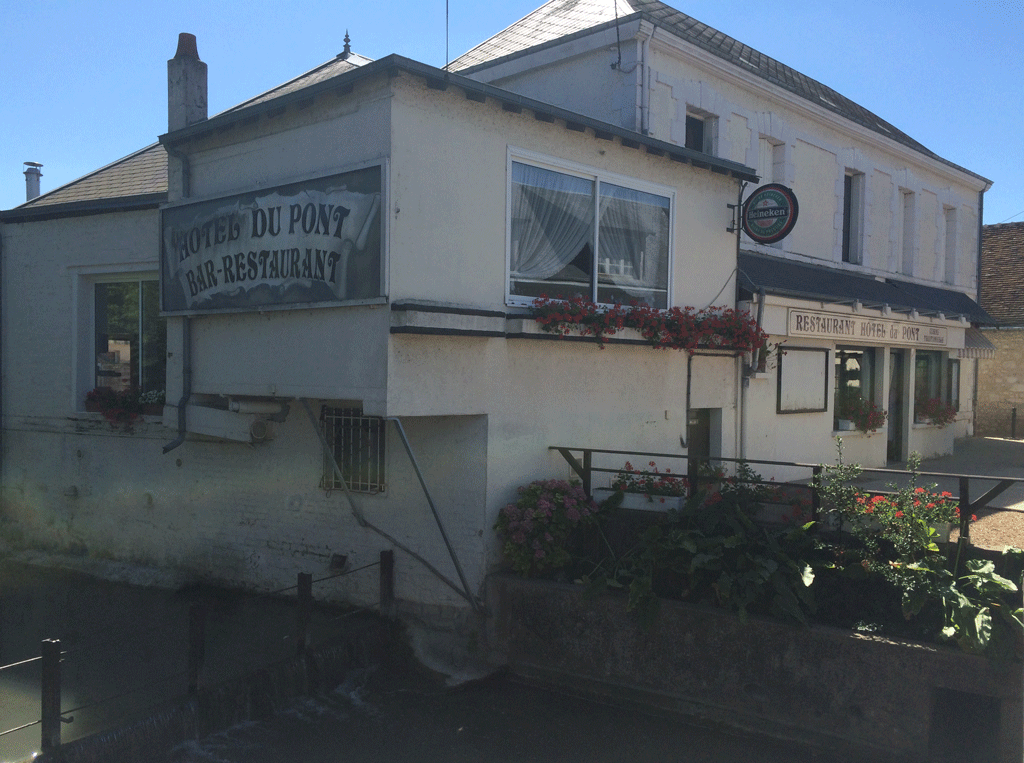
We keep following the little bike signs until we come to another very busy place: a train station that doubles as a wine-tasting venue. The red and white wine produced in the area is vendomois, made with chenin and pinot d’aunis grapes, a cousin of chenin blanc. The room is full of people so we don’t taste any wine.
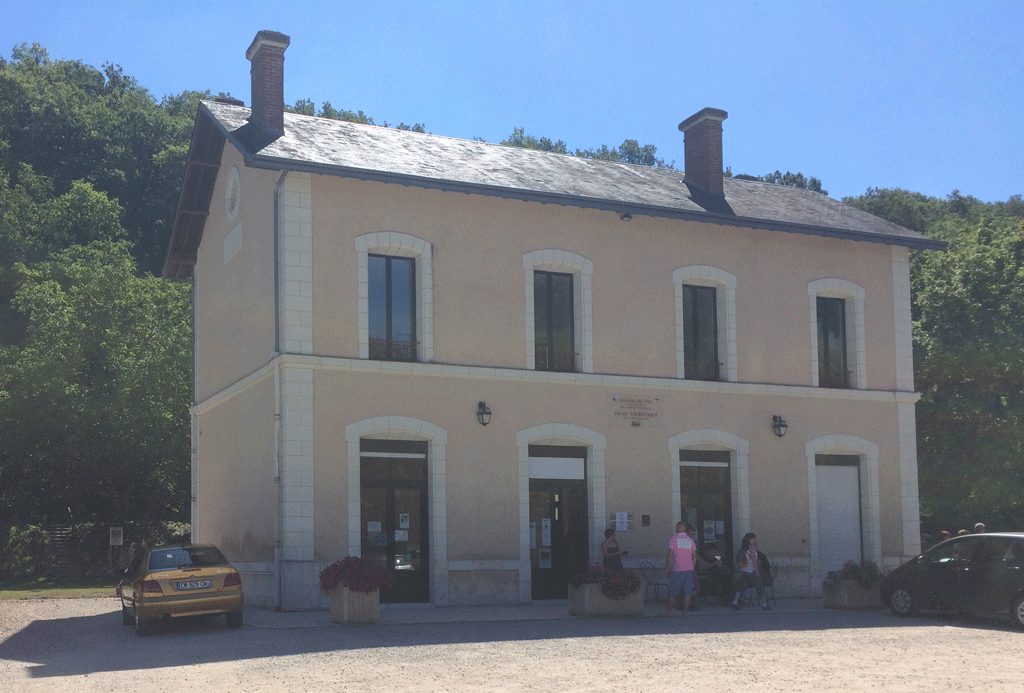
The station has been rehabilitated for the Loir Valley tourist train, a rural railcar from the 1950s. The 2 ¾ hour trip stops at the troglodyte village of Tröo and the “tunnel of history” in Montoire where Pétain and Hitler met up during the Second World War. I try out the “dry toilets” and wonder why there aren’t more along the bike paths in France.
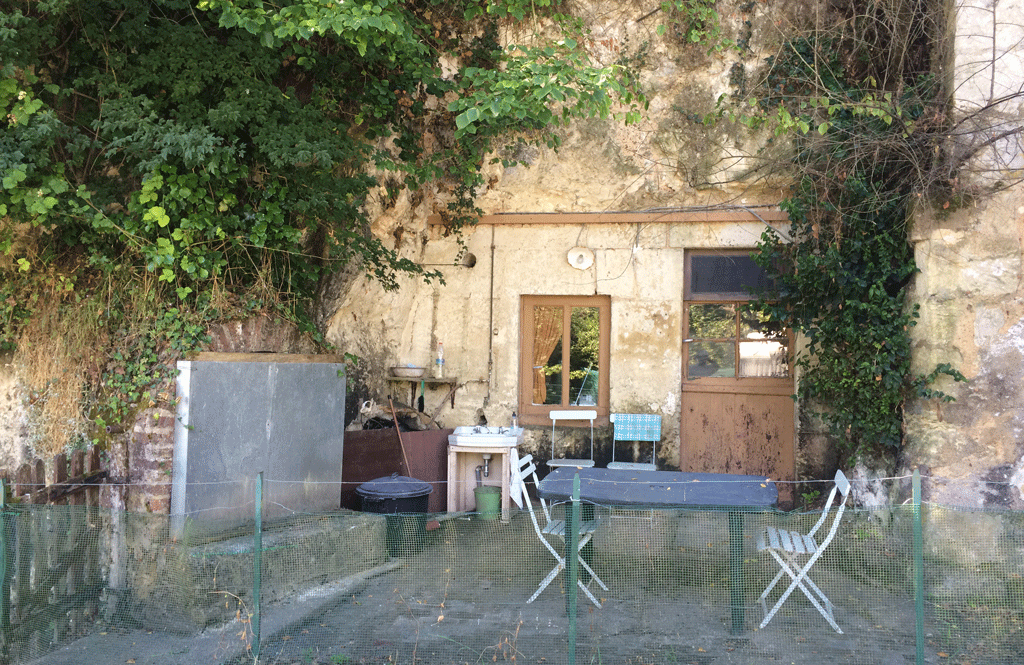
We continue towards Rimay past more troglodyte houses. What a pity we can’t have our picnic at this one!
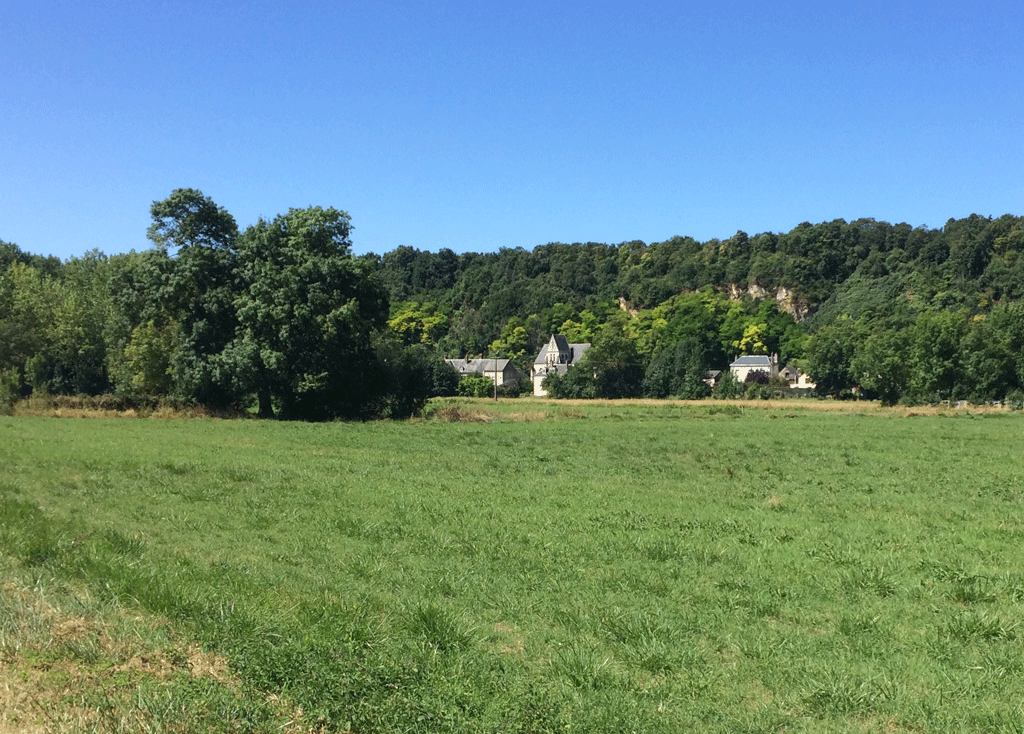
At one point we can see the ruined castle of Lavardin in the distance. With some difficulty regarding signage (our itinerary no longer coincides with the Loire à Vélo bike route), we arrive in Montoire. We should have gone to the left of the roundabout with the waterwheel and not to the right.
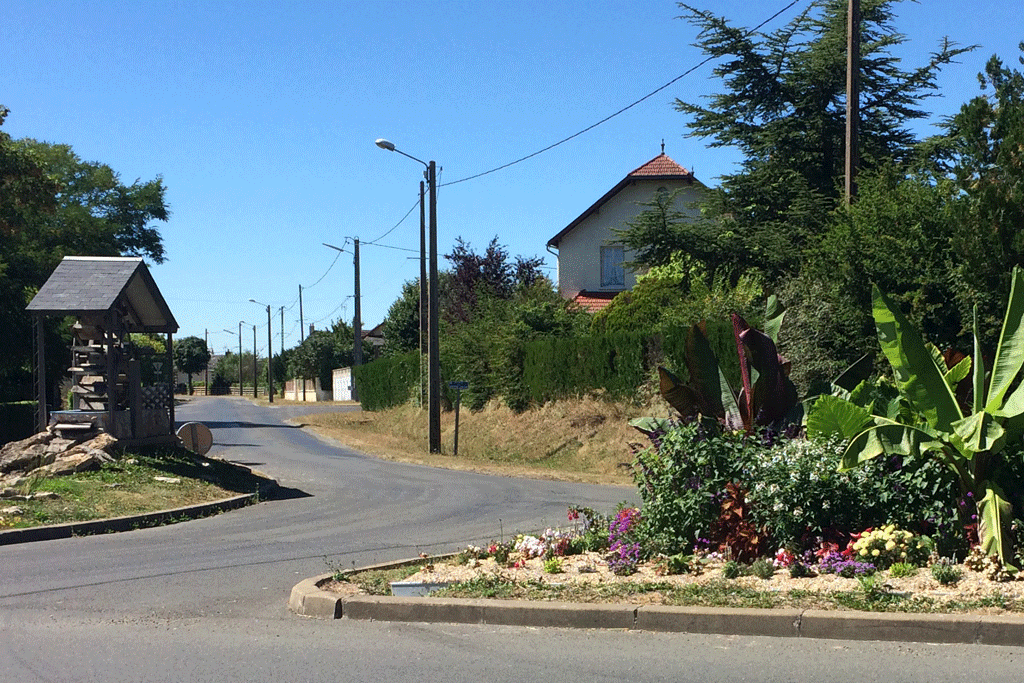
I don’t know the reason behind the flags on the town hall in Montoire but I find them very attractive.
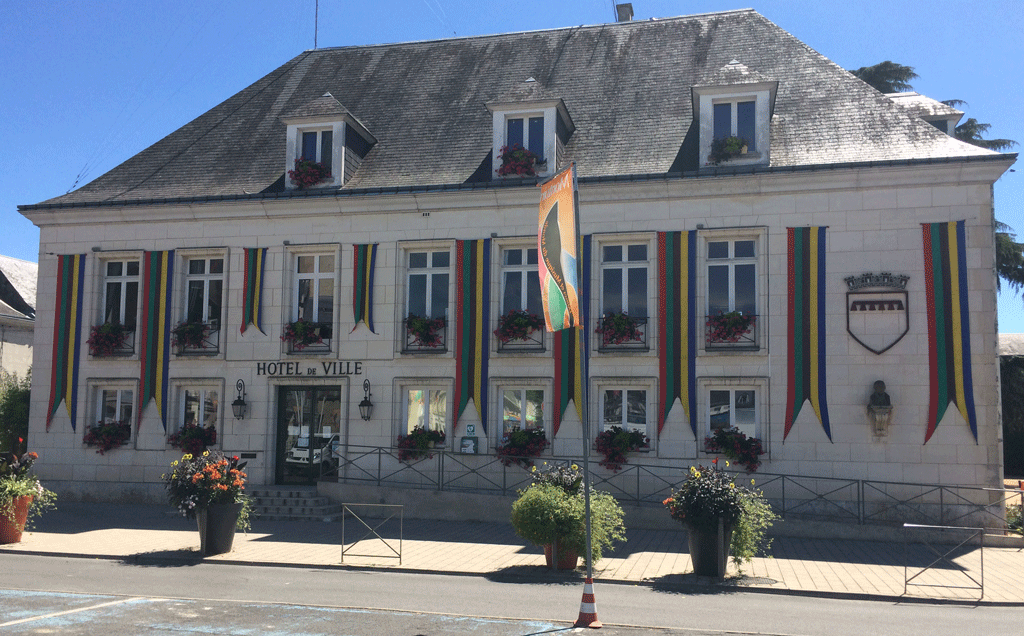
We finally reach Lavardin where we’re hoping to find some shady picnic tables. We find the tables – 8 of them, but only two are in the shade and both are occupied. Everyone else is picnicking on rugs on the ground.
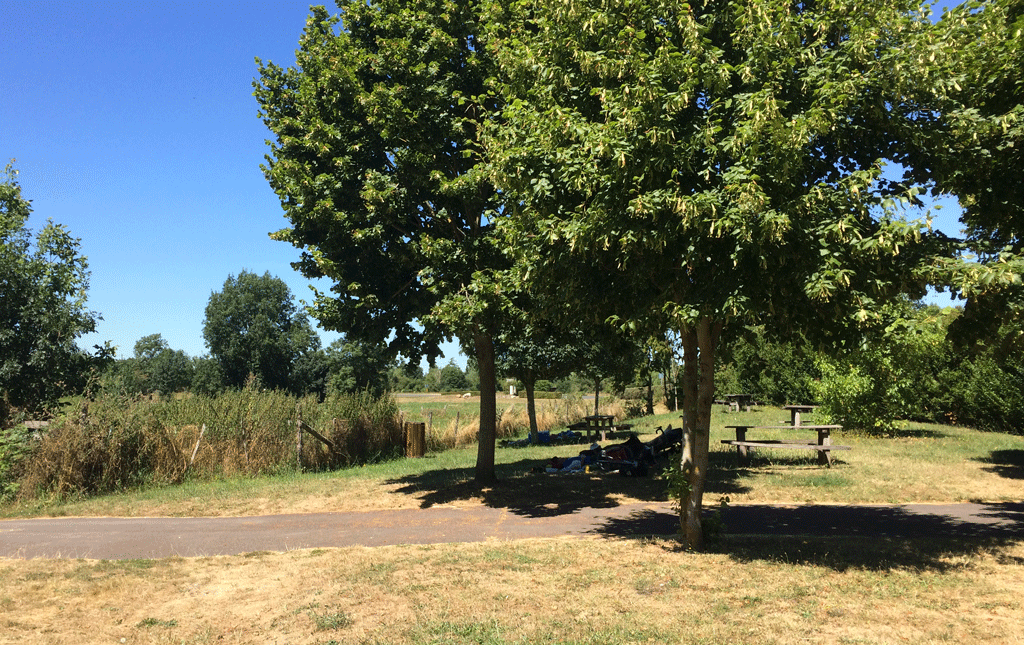
As we continue on to Lavardin, we see the perfect place to picnic – shady tables on the banks of the Loir. Sigh.
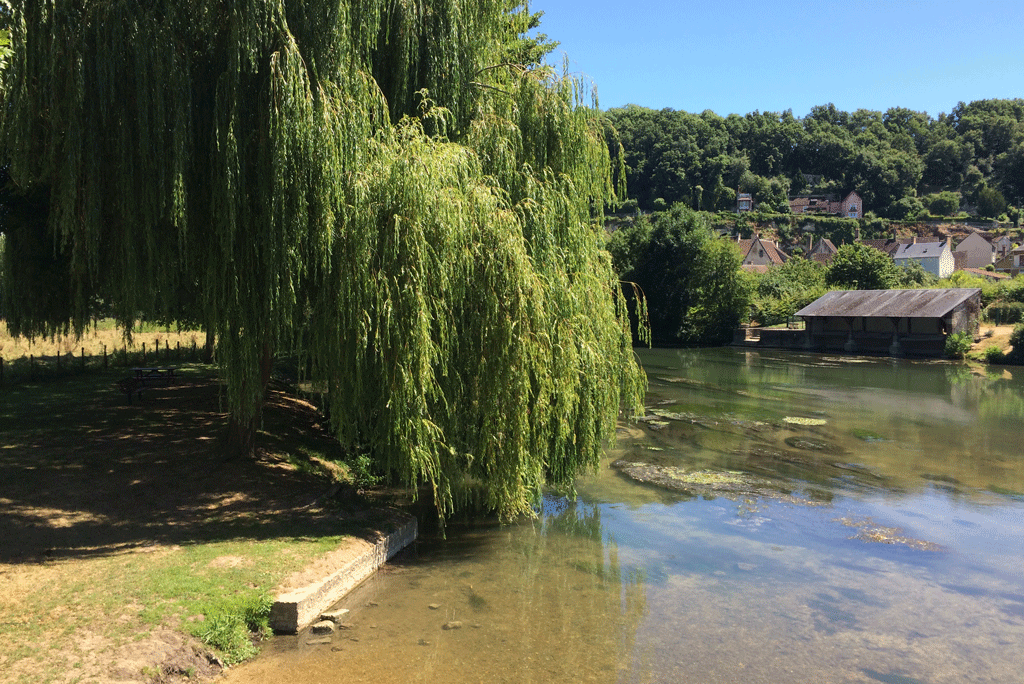
Lavardin itself is much prettier without the Christmas market. We have a café gourmand in an open-air restaurant with a view of the castle. There is a stand with tourist leaflets on it and I pick up one mentioning the murals and frescos in the church of Saint Genest which we were not able to visit last time.
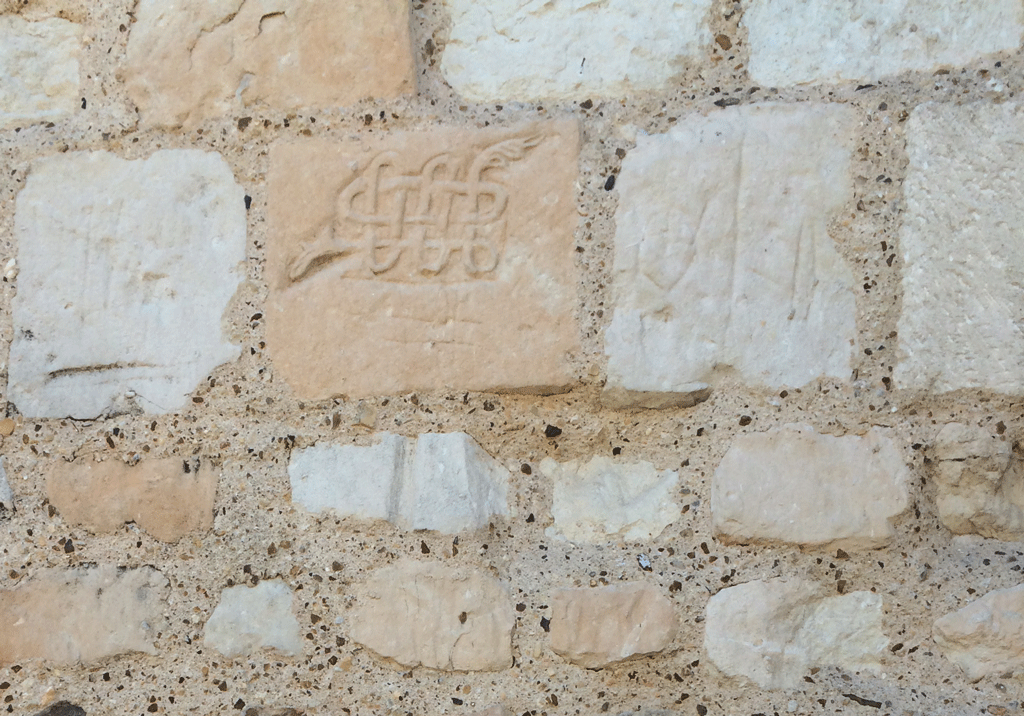
We walk around it as directed to find the sculpted stones that were included in the façade when it was built.
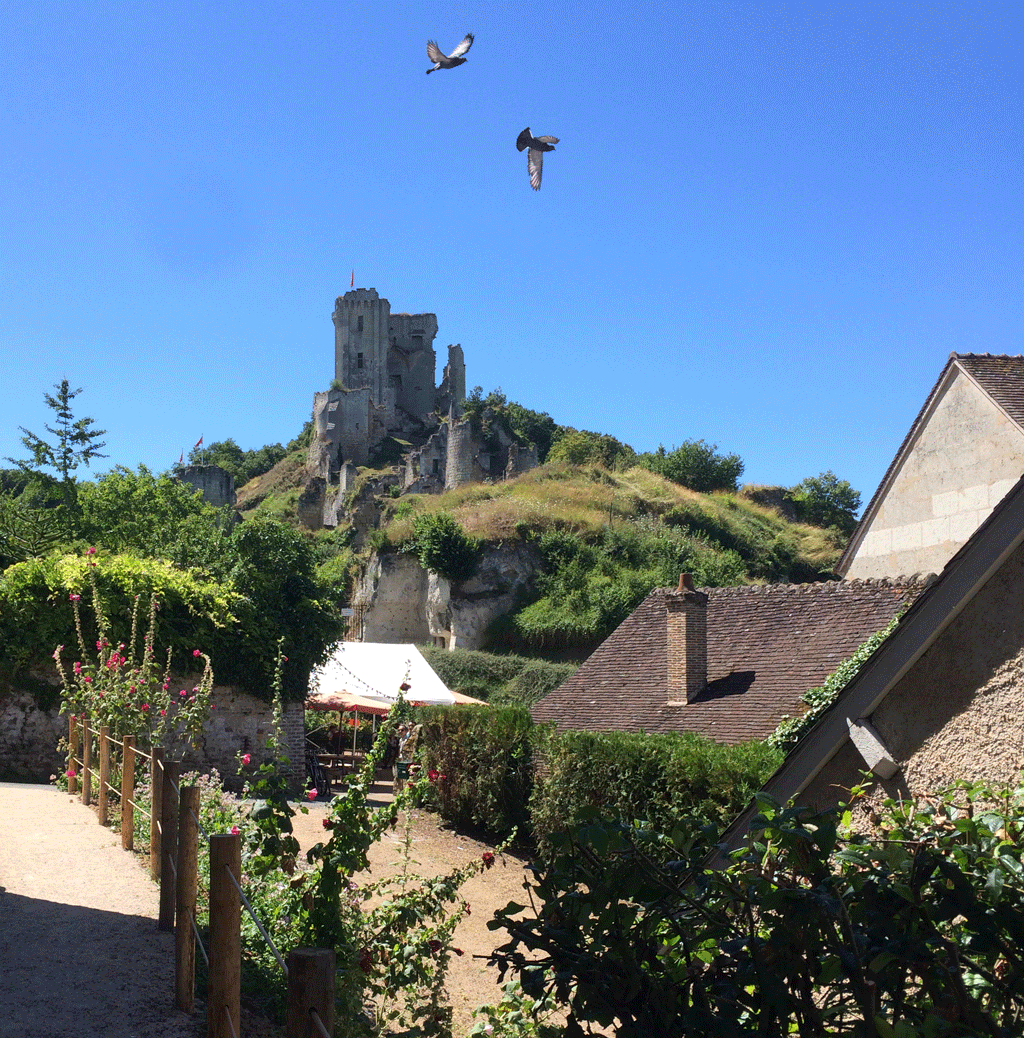
It proves to have a perfect view of the castle as well.
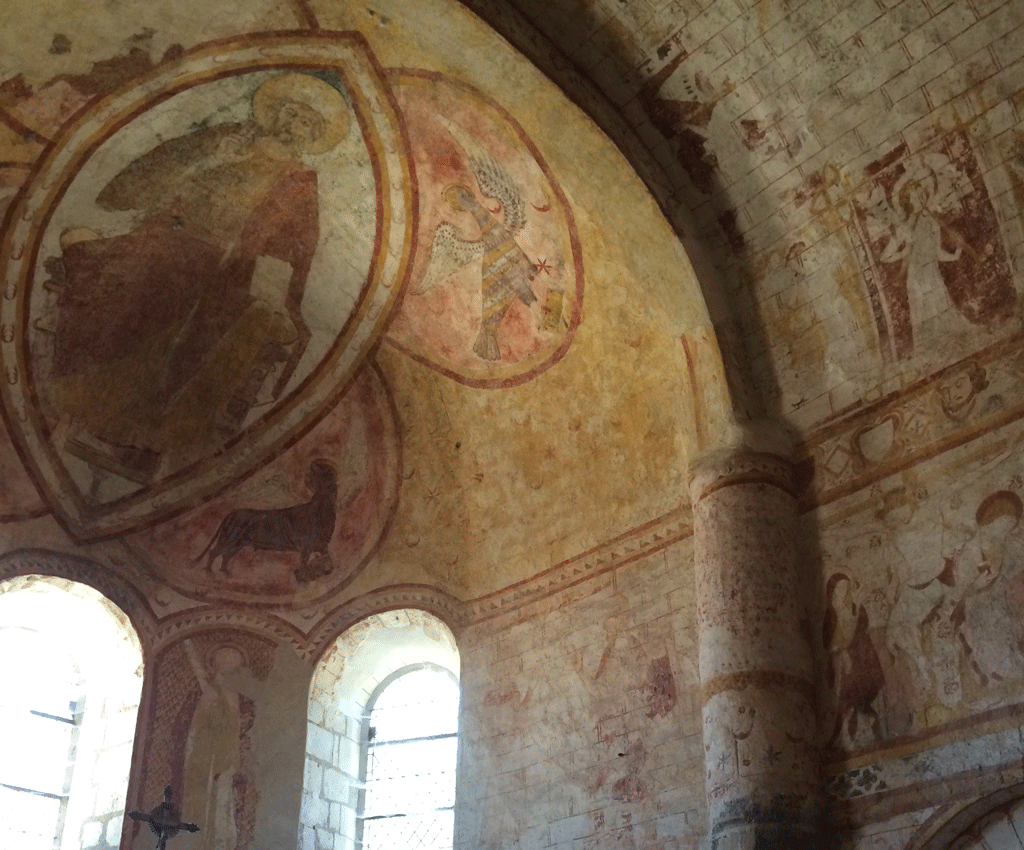
Inside we discover a magnificent series of wall paintings, two frescos and painted capitals that are well worth a visit.
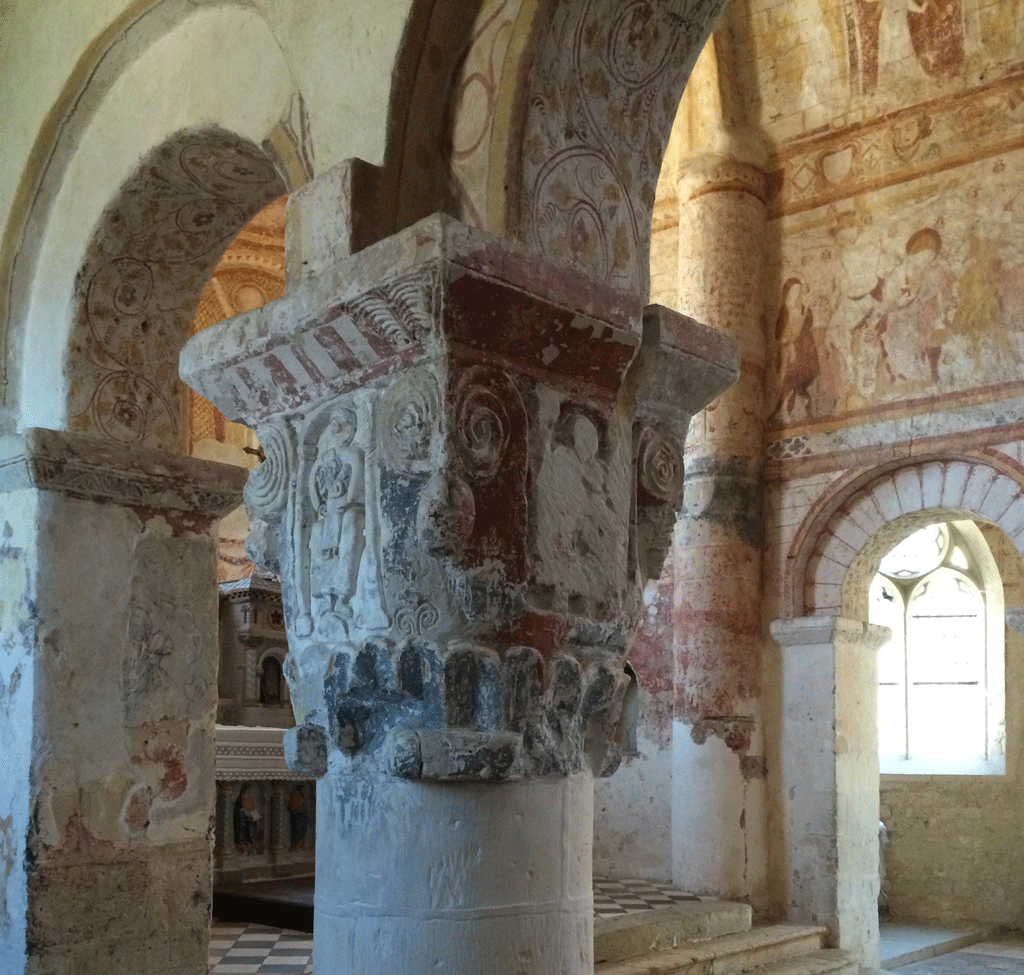
Afterwards, we walk up the hill towards the castle so I can take some more photos. We can now see the church of Saint Genest in full.
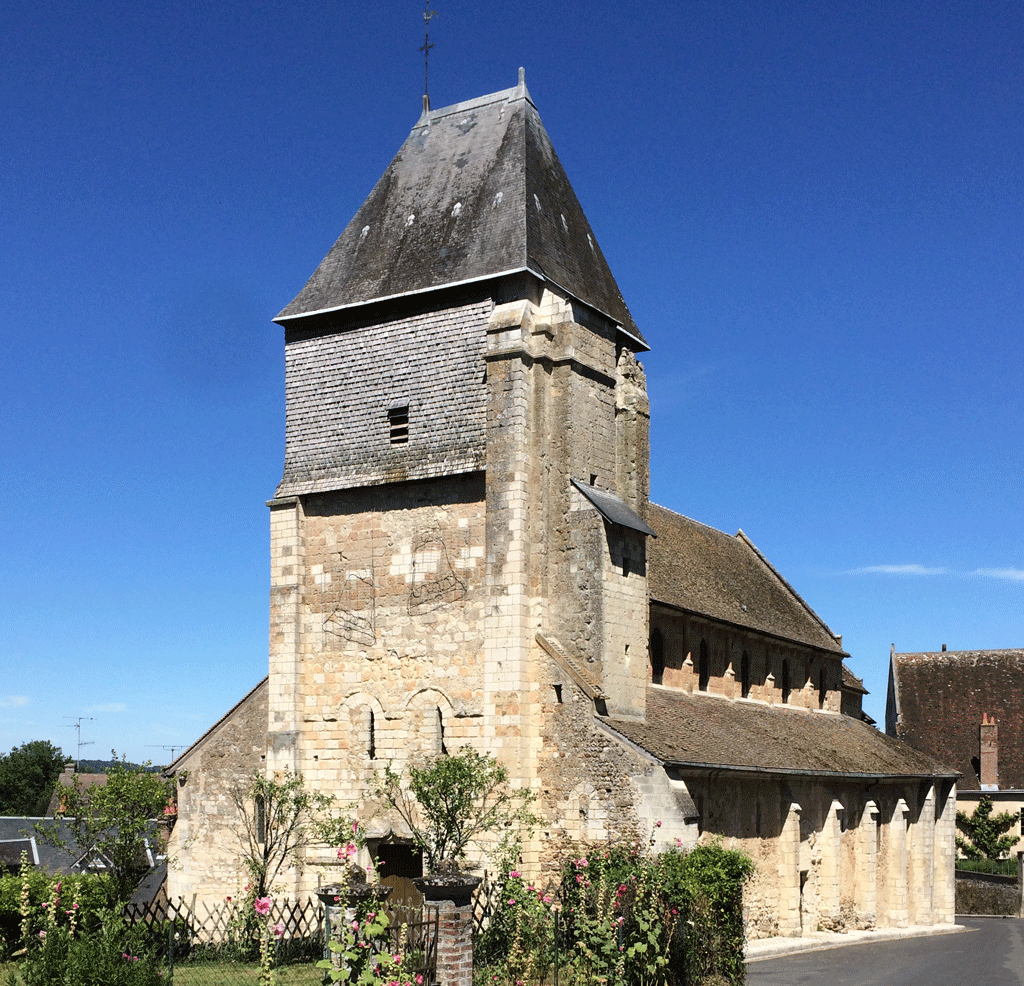
The castle is certainly photogenic. Founded by the Counts of Vendôme in the 9th century, it was rebuilt in the 14th and 15th century by John 1st of Bourbon-Vendôme. After being occupied by members of the Catholic league, it was captured and dismantled on the orders of Henri IV in 1590. All that is left of the feuldal castle is a 26-metre high rectangular keep with flat buttresses topped with crenallations. The only remaining part of the two walls built in the 14th and 15th centuries is the entrance flanked by two circular towers and a drawbridge over a moat.
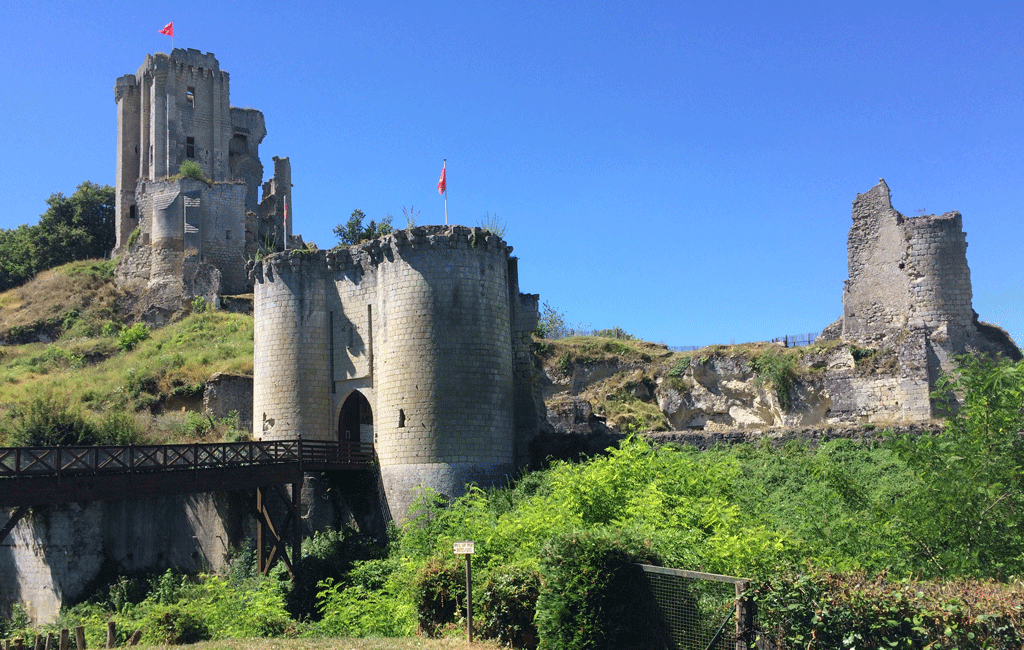
We head out of town and past a magnificent Pierre Ronsard rose bush and a church for sale, then have to backtrack. We’re in the wrong direction again.
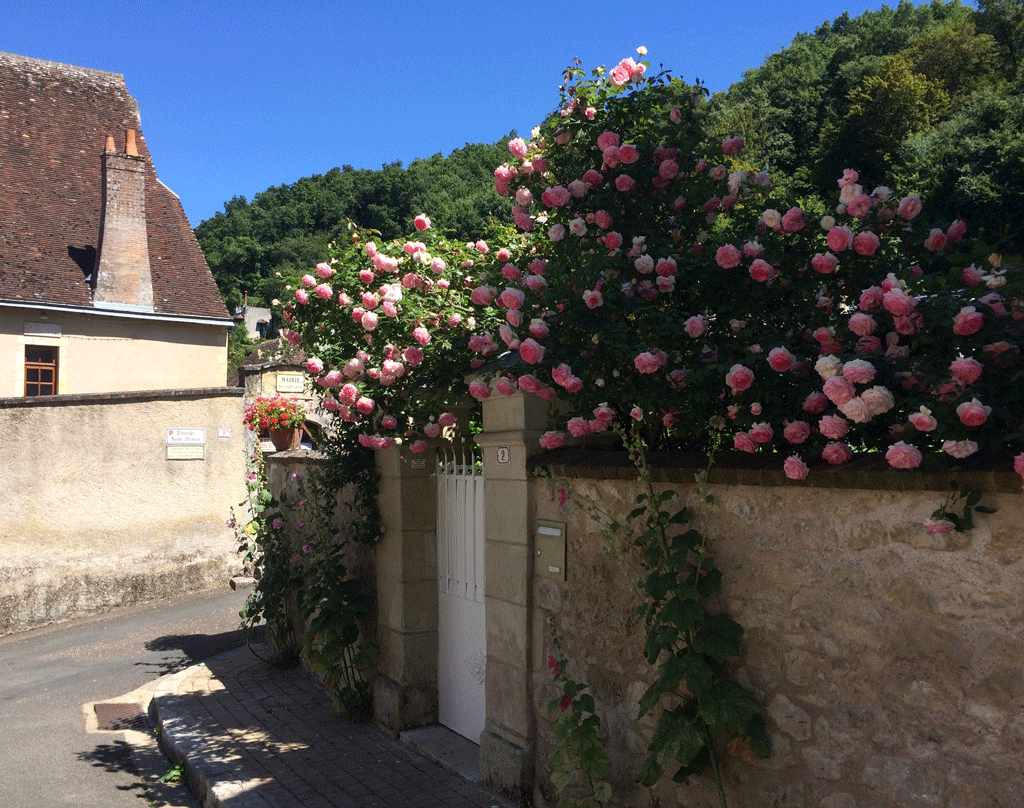
We arrive at the waterwheel roundabout just in time to see the tourist train go by.
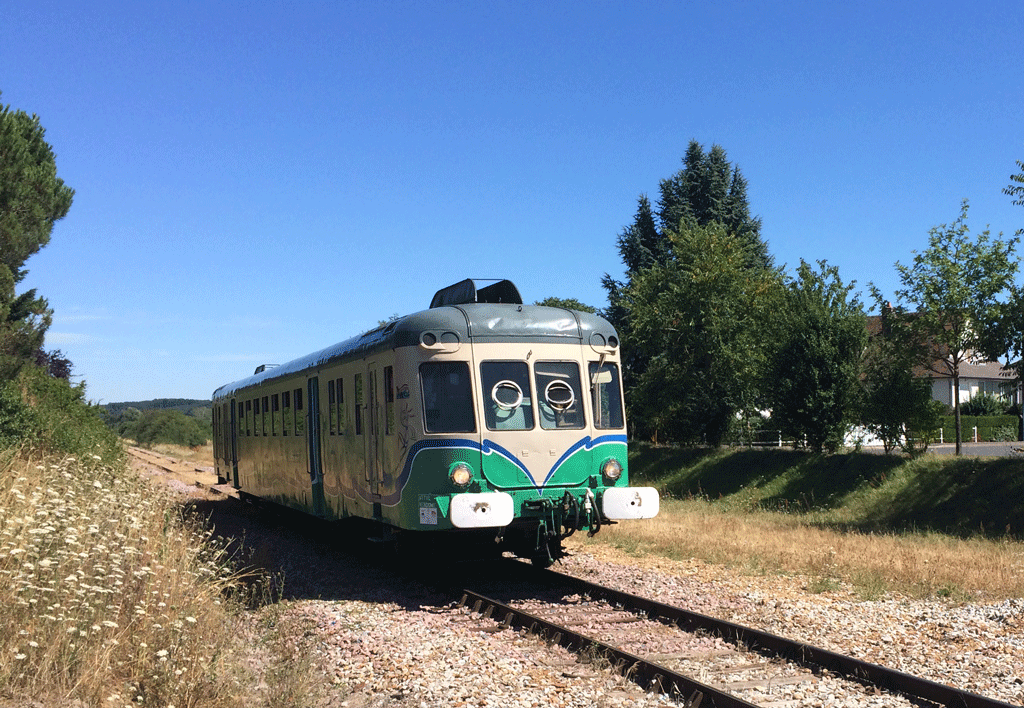
Our itinerary takes along the Loir and past more troglodyte houses.
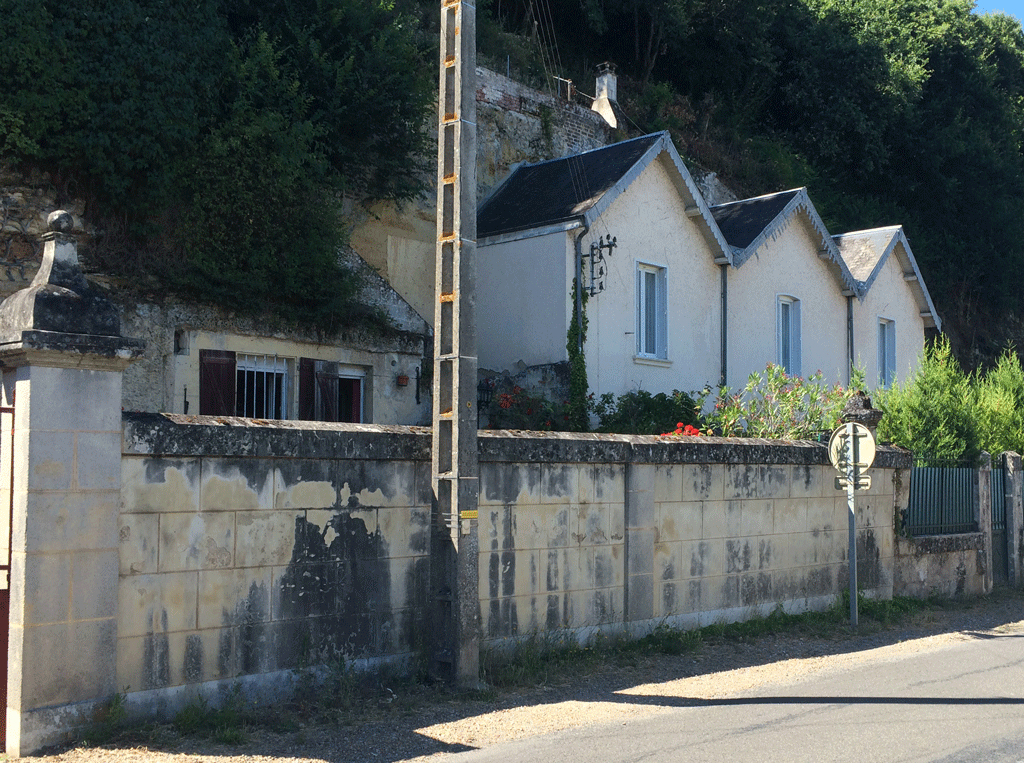
We come to the little town of Les Roches d’Evêque whose church has an unusual buttress and see another shady picnic table that we now no longer need.
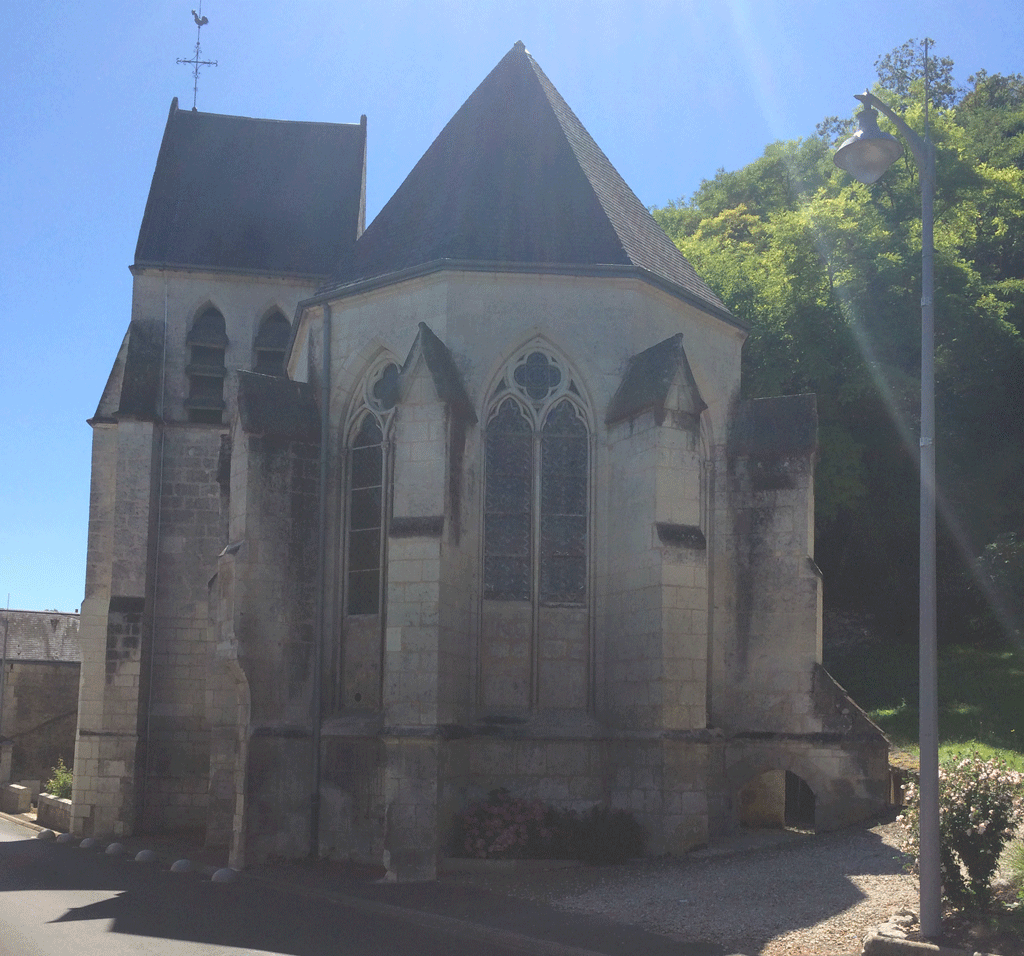
After more troglodyte houses, one of which is three stories high, we find ourselves on a busy road with cars speeding past at 90 kph. I see a sign off to the right saying Château Mézière so suggest we follow it.
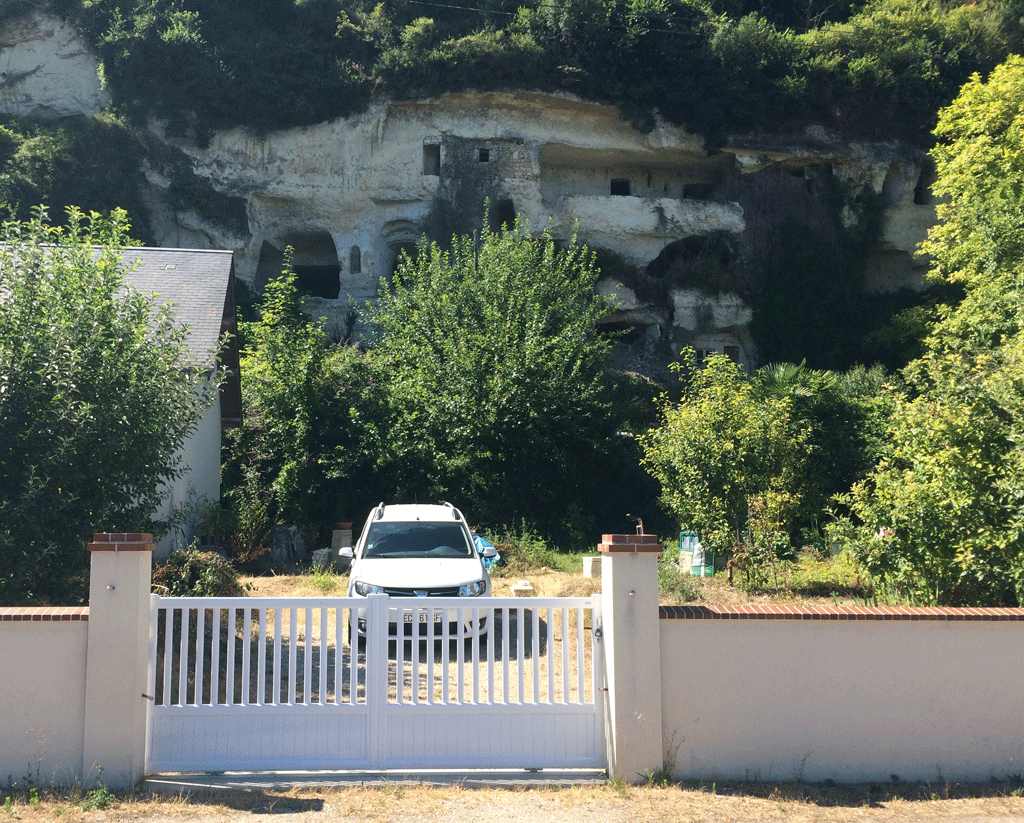
It’s worth the detour! There is a beautiful Renaissance porch, a moat, a stately main building, a chapel, a boat landing and an orangery, all very romantic and used today as a wedding venue.
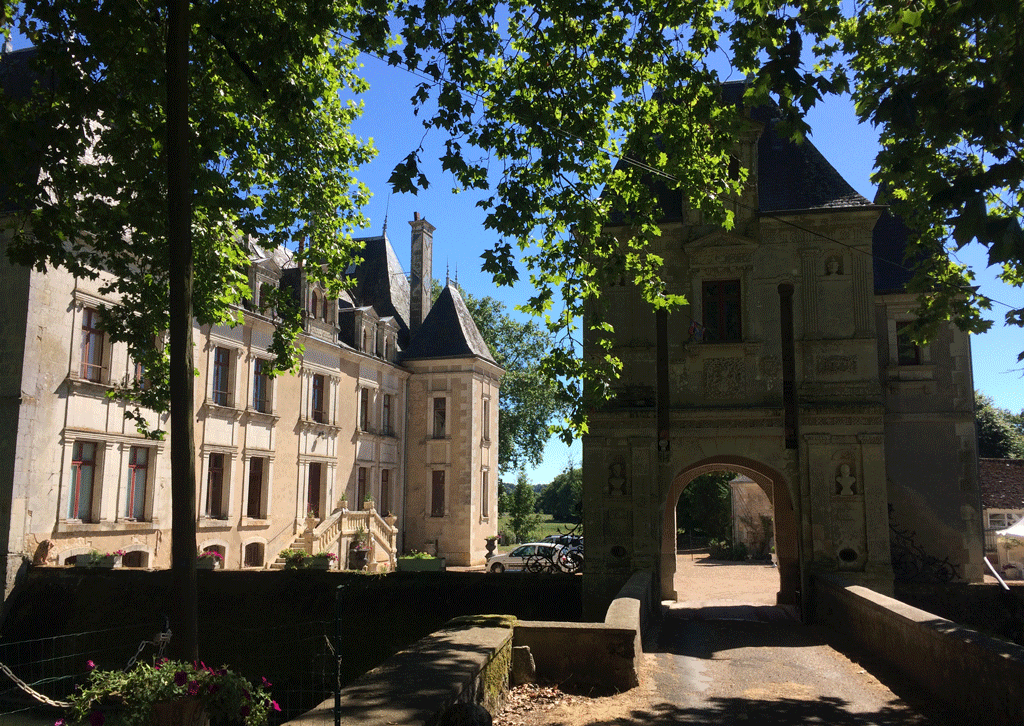
Unfortunately the upkeep must be enormous and much of the main building is very dilapidated.
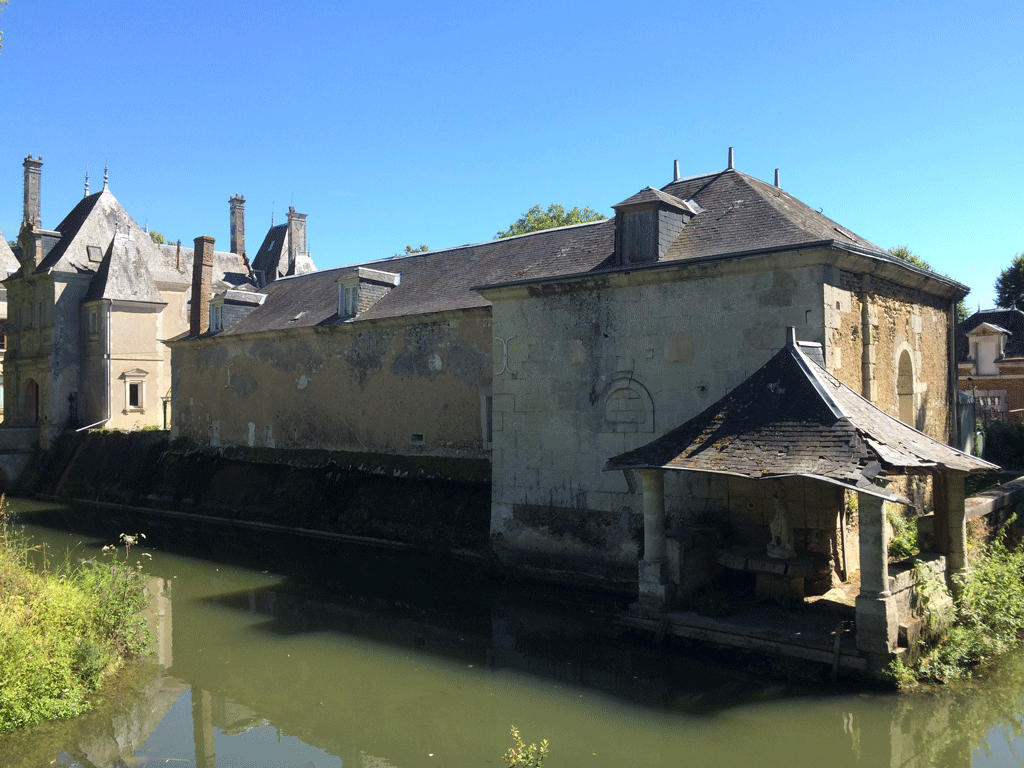
There is a sign under the porch saying that visitors are welcome to walk around the outside without charge.
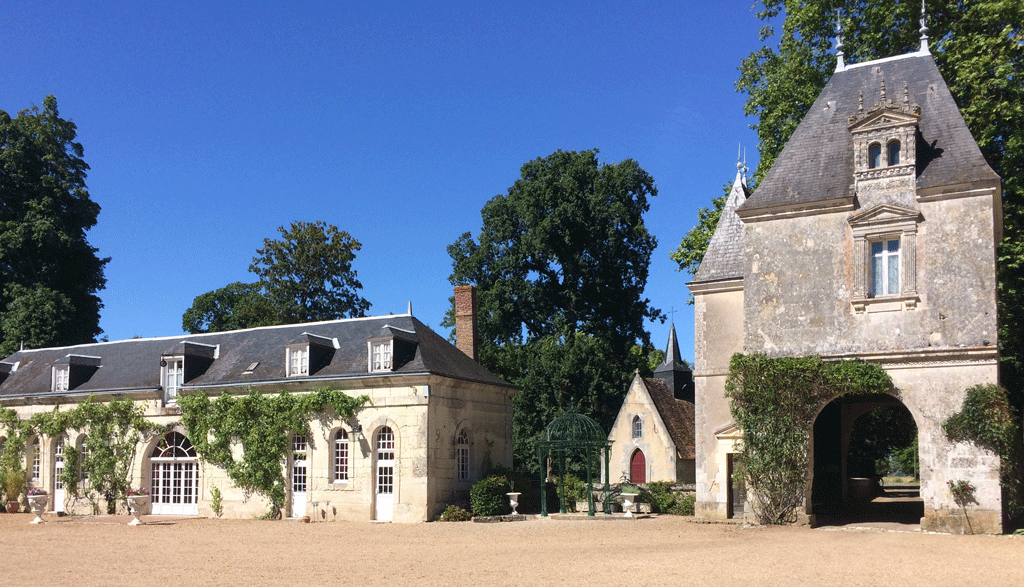
By the time we arrive back at Villiers, we are ready for an ice-cream. I know there is no hope of finding anything that might resemble a German Eiscafé but I’m hoping they might have a Miko.
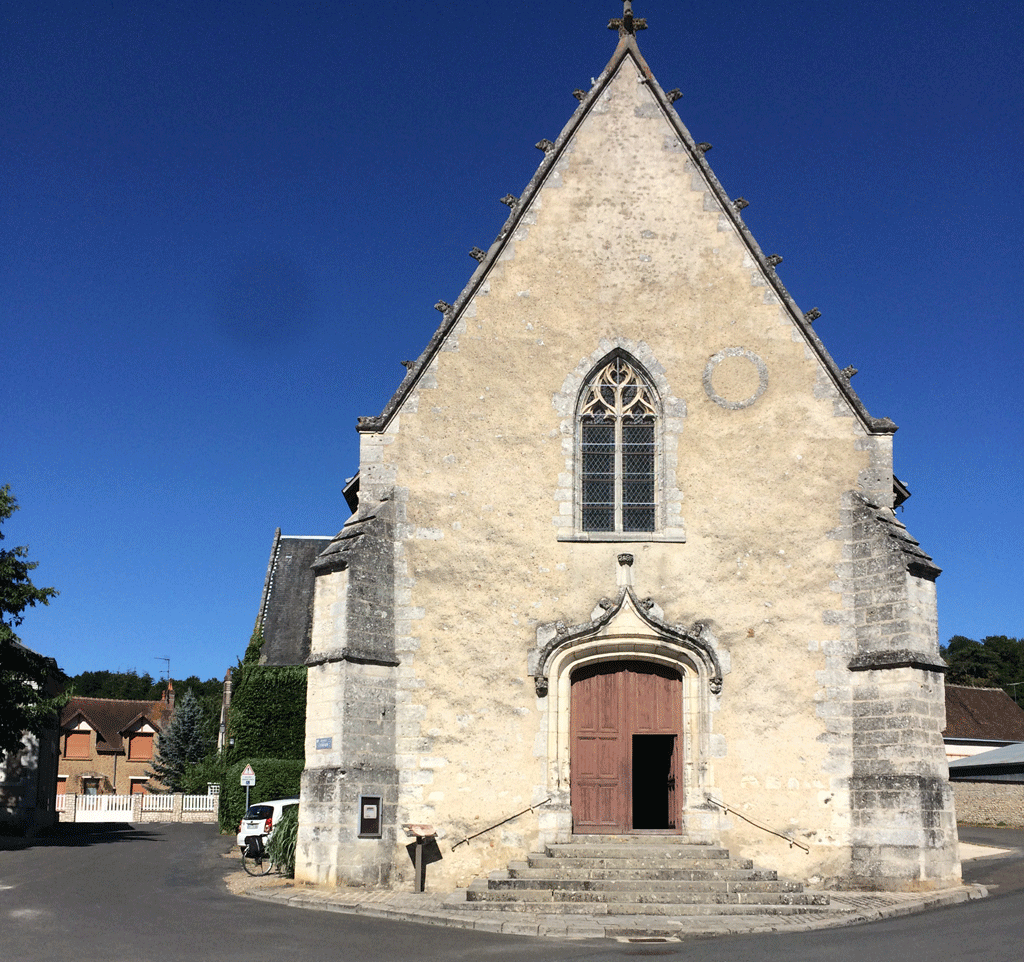
The main square in Villiers is TOTALLY deserted. Nothing is open. So we visit the inside of the church of Saint Hilaire which has 16th century wall paintings along one side known as the “three living and the three dead”: three young rakes are called into a cemetery by three dead who remind them of the brevity of life and the importance of saving their souls.
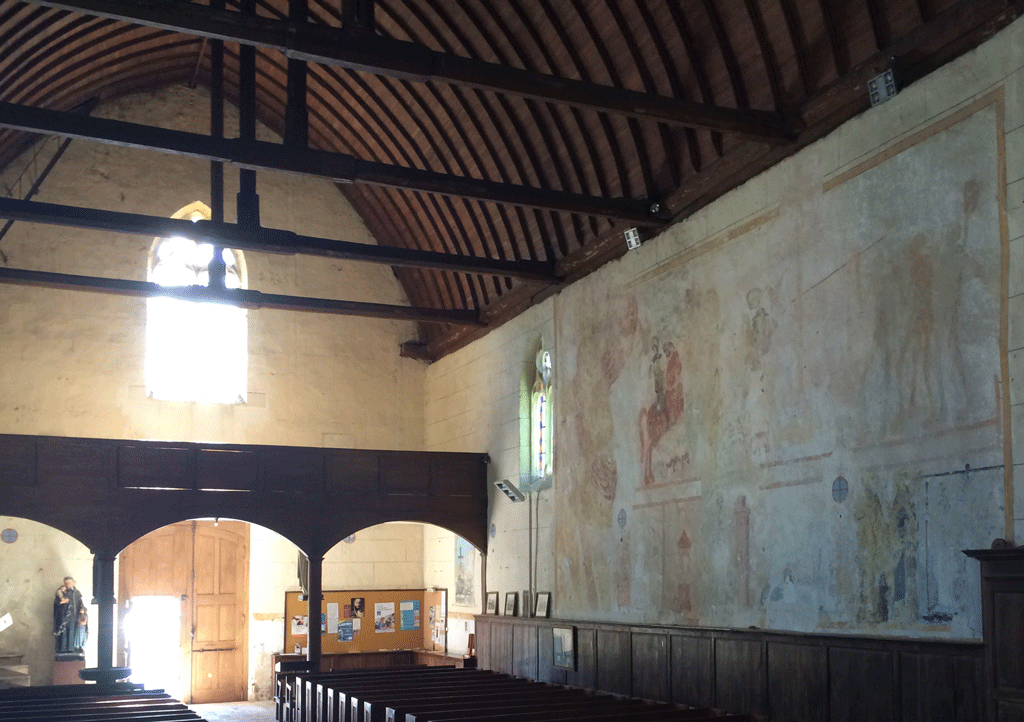
The stalls in the chancel have some interesting sculptures as well.
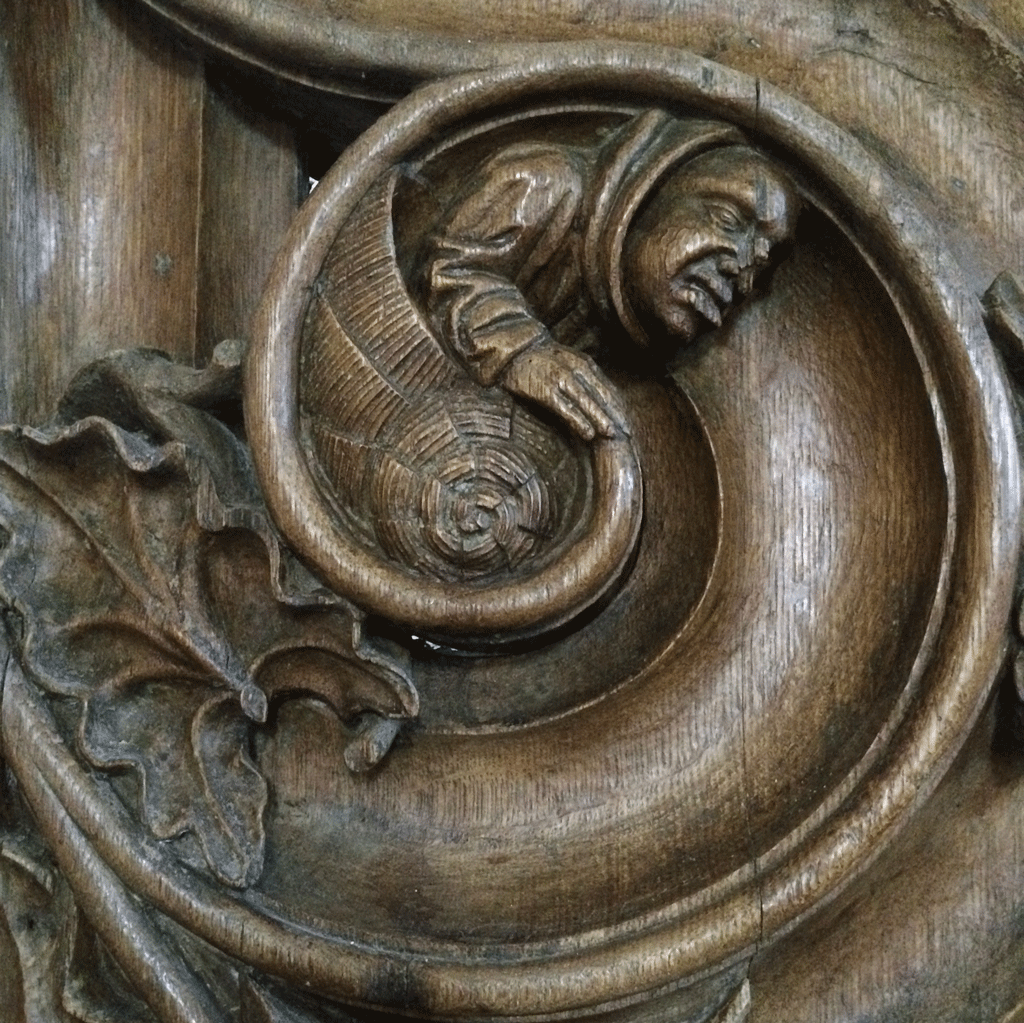
Jean Michel takes a photo of a curious motif on a wall which turns out to be a clock jack made by Alain Henry, a copper manufacturer in Villiers, with the help of a fellow craftsman from Bourges. It recalls the legend of the Serpent’s Hole. Unfortunately, it is no longer in operation.
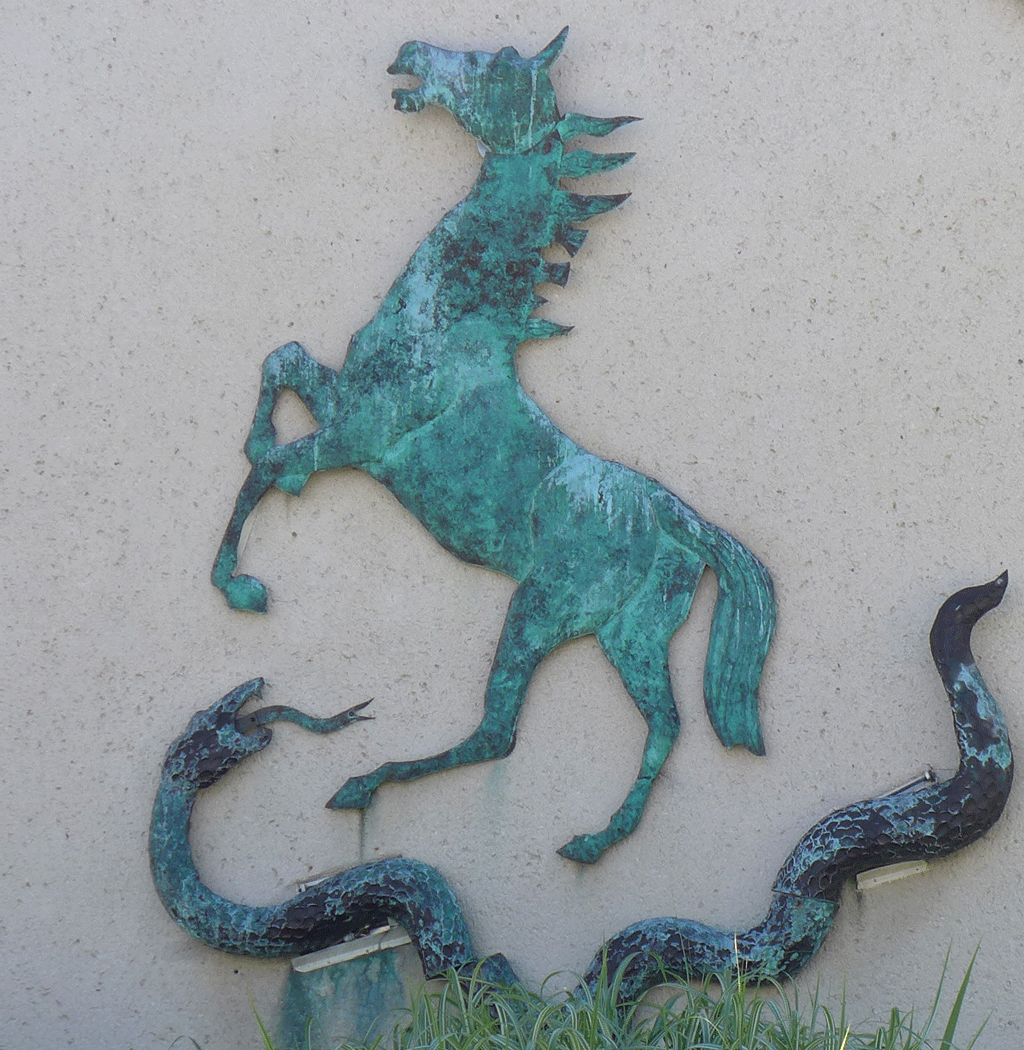
According the legend, in the time of the Merovingian king, Childebert I, who lived in the area, a dragon was terrorizing the population. Its den was a cave honed out of rock in Saint-André. The king ordered one of his prisoners, Brayanus, to kill the monster, in exchange for his freedom. Brayanus, mounting a chariot with long sharp steel blades attached to the wheels, charged at the monster while it was slaking its thirst in the river and cut it into three pieces.
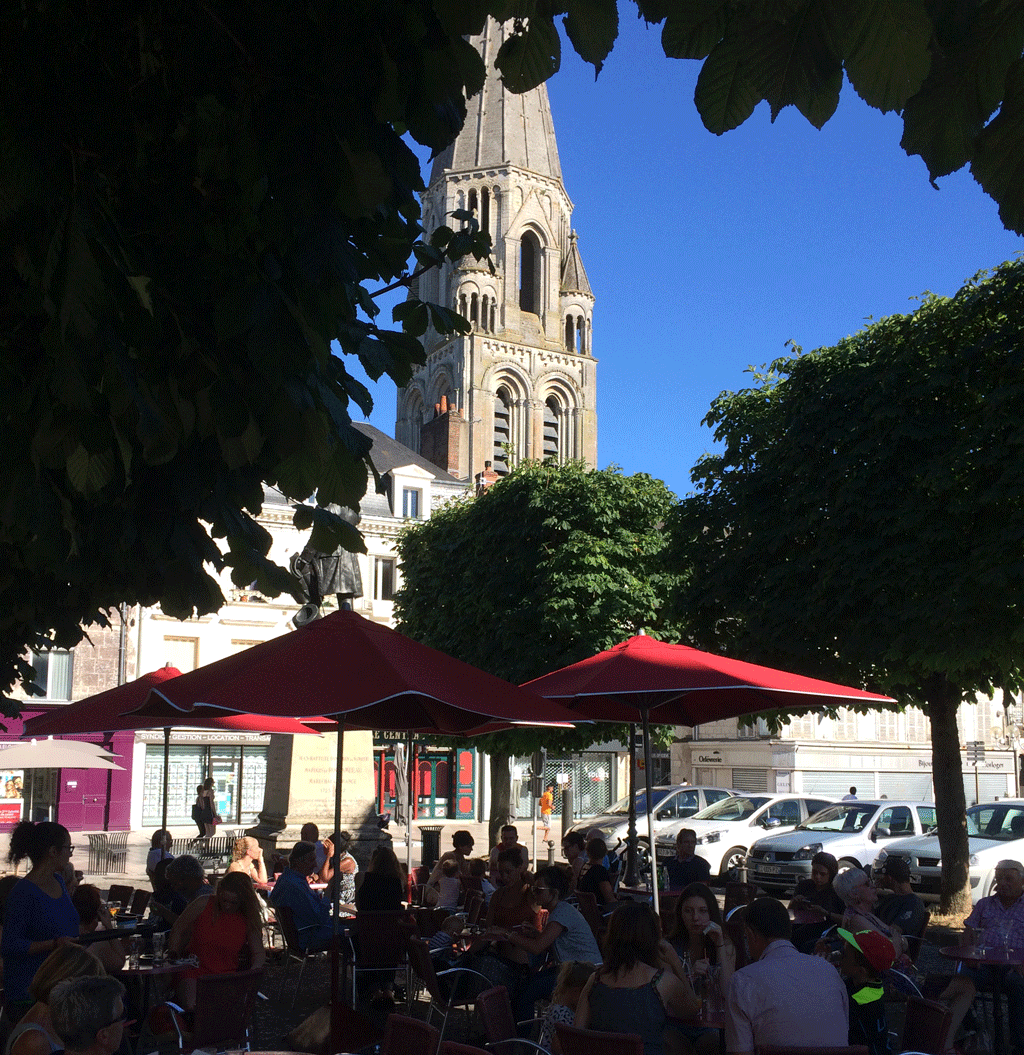
We ride back to the car having clocked up 38 km and 2 hours 40 minutes and Jean Michel suggests we go to Vendôme for an ice-cream as it’s only 10 minutes by car. We find a vendor on Place Saint Martin that only has about six uninteresting flavours so we go looking for somewhere else.
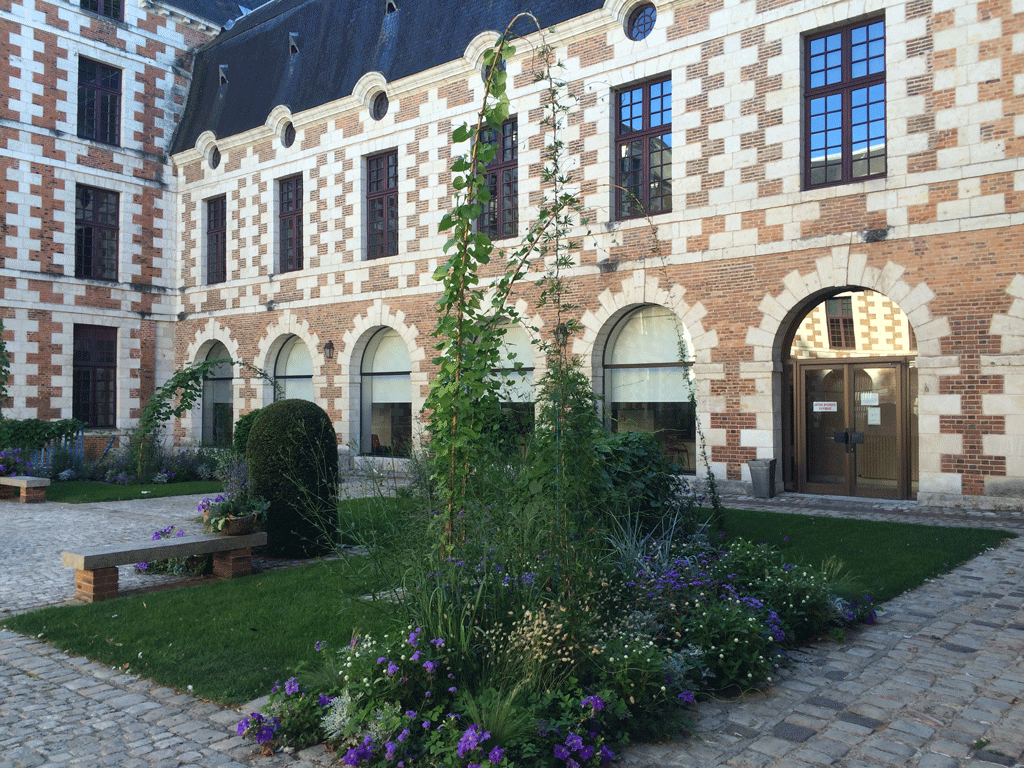
Although we enjoy walking through the streets of Vendôme, which we have visited several times in the past, we do not find any other ice-cream vendors so go back to Place Saint Martin.
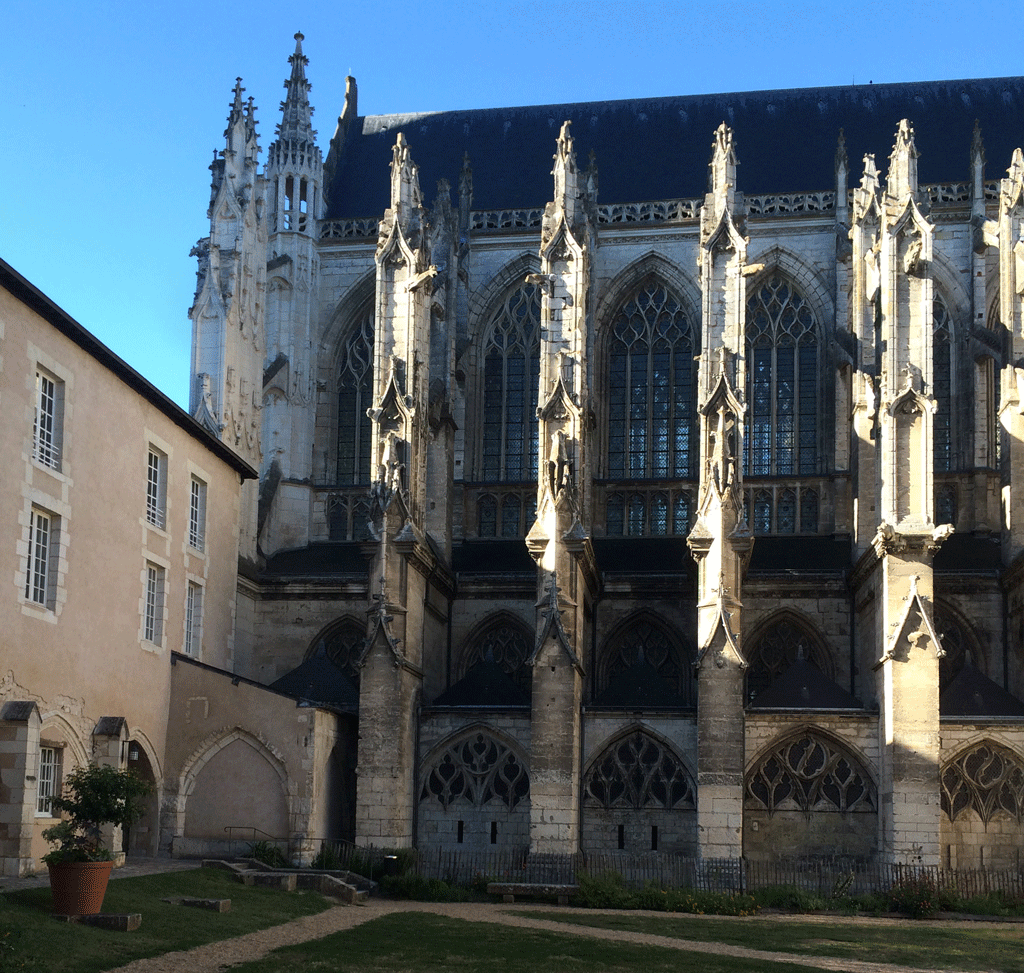
The result if very disappointing. Even Carte d’Or ice-cream is better! But we eat them in the cathedral cloisters and enjoy the view of the sun setting over the buttresses.
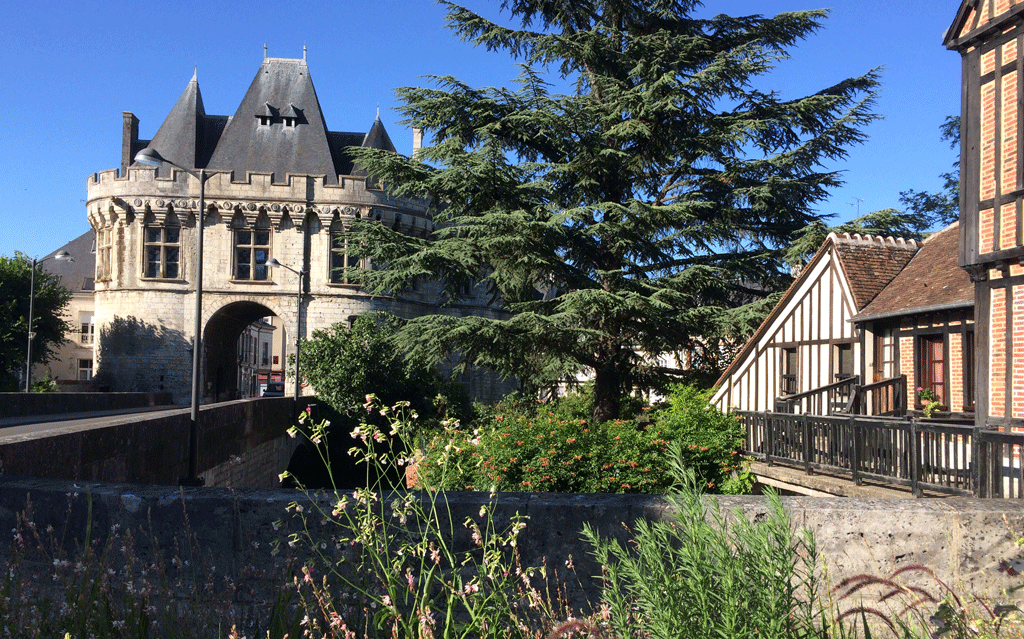
I later discover, to my great dismay, that we missed two major monuments along the bike path – Saint Rimay tunnel where Pétain and Hitler meet up during the Second World War and St Gilles Chapel in Montoire which was the priory of the poet Ronsard from 1566 until his death in 1585. It is said to have murals of exceptional symbolism painted in the 11th to 13th century. We’ll have to go back! But next time, we shall start in Vendôme and follow the little green and white bikes the whole time. That way, we won’t keep getting lost. Or maybe we should just take the tourist train.





I’m exhausted. So much to take in. I wonder what it is like to live in a troglodyte house.
Upkeep, heating, lighting. At what time is your sun setting? The sky looked very bright.
Yes, we seem to have packed in an incredible amount in one day – it took me three to write the post :).
Today, on another bike route, we were invited into a troglodyte home so I’ll be able to answer your questions!
It is properly dark at about 9.45 pm at the moment, but still completely light until 9 pm.
The castle ruins are a delightful sight among these shots. Beautifully photographed!
Thank you.
That church at Villiers looks jolly interesting.
I wonder how much of a connection to Ronsard the priory you mention has? It was not where he lived, worked or died (that’s the Prieuré de Saint Cosme in La Riche near Tours). Although he did move around a bit in the course of his official duties…
Yes, I thought you’d like it!
According to vendome-tourisme.fr, Ronsard was the prior from 1566 until his death in 1585. We haven’t been to Saint Cosmes either.
Beautiful shots.
Thank you Karlfest! Hope you’ll come and join us some time.